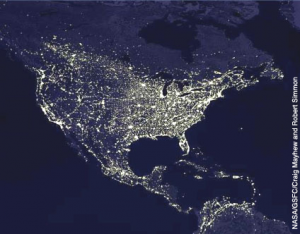Light Pollution
Note: all information on this page is public content and may be referenced back to the International Dark Sky Association (IDA)
For most of Earth’s history, our spectacular Universe of stars and galaxies has been visible in the darkness of the night sky. From our earliest beginnings, this cosmic array has inspired questions about our Universe and our relation to it. The history of scientific discovery, art, literature, astronomy, navigation, exploration, philosophy, and even human curiosity itself would be diminished without our view of the stars. But today, the increasing number of people living in cities and the corresponding increase in inappropriate and unshielded outdoor lighting has resulted in light pollution—a brightening night sky that has obliterated the stars for much of the world’s population. Most people must travel far from home, away from the glow of artificial lighting, to experience the awe-inspiring expanse of the Milky Way as our ancestors once knew it.
What is Light Pollution? Light pollution is excessive and inappropriate artificial light. The four components of light pollution are often combined and overlapping: Why Do We Care About Light Pollution? Increased urban sky glow is responsible for the disappearance of the Milky Way from our night skies. For professional astronomers, the increasing distance to prime observing sites, well away from sources of air pollution and urban sky glow, becomes more problematic as economic and environmental energy costs continue to rise. Amateur astronomers, meanwhile, find prime observing spots eradicated by commercial and residential development and must travel farther from home for a clear view of the skies. Increasingly, the most important equipment needed to enjoy the wonders of the night sky is an automobile with a full tank of gas and a map. Light pollution is a problem beyond Astronomy and you may read more about its adverse effects here: Ok, So What Can I Do About It? There are very simple and practical things that one can do to help minimize contributions to light pollution: How Can I Find Out More? Watch this great video about the science of the dark and an exploration of our relationship to the stars by filmmaker Ian Cheney. For more information on buying dark sky approved fixtures visit Volt Lighting’s page: Using Dark Sky Approved Lighting to Reduce Light Pollution. Find out about the hidden costs of light pollution. You may always contact us for more information.
Visit  International Dark Skies (IDA) website for more information. McDonald Observatory has another great page summarizing Light Pollution and how to fight it.
International Dark Skies (IDA) website for more information. McDonald Observatory has another great page summarizing Light Pollution and how to fight it.


